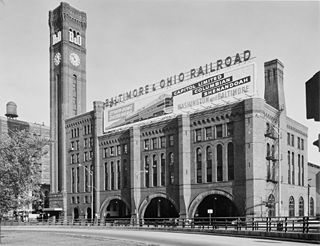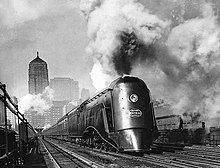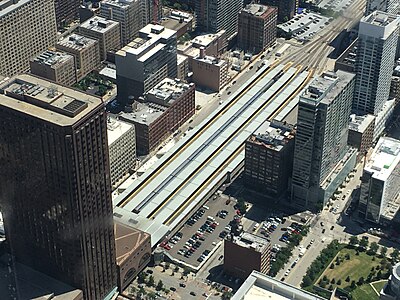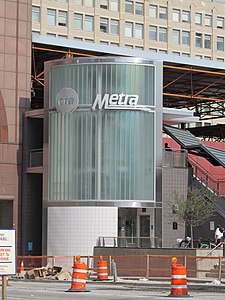
The original Chicago, Rock Island and Pacific Railroad was an American Class I railroad. It was also known as the Rock Island Line, or, in its final years, The Rock.

Metra is the primary commuter rail system in the Chicago metropolitan area serving the city of Chicago and its surrounding suburbs via the Union Pacific Railroad, BNSF Railway, and other railroads. The system operates 242 stations on 11 rail lines. It is the fourth busiest commuter rail system in the United States by ridership and the largest and busiest commuter rail system outside the New York City metropolitan area. In 2023, the system had a ridership of 31,894,900, or about 152,400 per weekday as of the fourth quarter of 2023. The estimated busiest day for Metra ridership occurred on November 4, 2016—the day of the Chicago Cubs 2016 World Series victory rally.

Dearborn Station was, beginning in the late 1800s, one of six intercity train stations serving downtown Chicago, Illinois. It remained in operation until May 1, 1971. Built in 1883, it is located at Dearborn and Polk Streets, to the south of the Loop, adjacent to Printers Row. The station was owned by the Chicago & Western Indiana Railroad, which itself was owned by the companies operating over its line. The station building headhouse now houses office, retail, and entertainment spaces, and its trackage yard, behind the headhouse, was redeveloped into part of the Dearborn Park neighborhood.

Chicago Union Station is an intercity and commuter rail terminal located in the West Loop neighborhood of the Near West Side of Chicago. The station is Amtrak's flagship station in the Midwest. While serving long-distance passenger trains, it is also the downtown terminus for six Metra commuter lines. Union Station is just west of the Chicago River between West Adams Street and West Jackson Boulevard, adjacent to the Chicago Loop. Including approach and storage tracks, it covers about nine and a half city blocks.

The Grand Trunk Western Railroad Company was an American subsidiary of the Grand Trunk Railway, later of the Canadian National Railway operating in Michigan, Illinois, Indiana, and Ohio. Since a corporate restructuring in 1971, the railroad has been under CN's subsidiary holding company, the Grand Trunk Corporation. Grand Trunk Western's routes are part of CN's Michigan Division. Its primary mainline between Chicago and Port Huron, Michigan serves as a connection between railroad interchanges in Chicago and rail lines in eastern Canada and the Northeastern United States. The railroad's extensive trackage in Detroit and across southern Michigan has made it an essential link for the automotive industry as a hauler of parts and automobiles from manufacturing plants.

The Richard B. Ogilvie Transportation Center, on the site of the former Chicago and North Western Terminal, is a commuter rail terminal in downtown Chicago, Illinois. For the last century, this site has served as the primary terminal for the Chicago and North Western Railway and its successors Union Pacific and Metra. Intercity services had disappeared by the 1970s, but commuter services on the three ex-CNW mainlines, Metra's UP District lines, continue to terminate here. The tracks are elevated above street level. The old CNW terminal building was replaced in the mid 1980s with a modern skyscraper, the 500 West Madison Street building. The modern building occupies two square city blocks, bounded by Randolph Street and Madison Street to the north and south and by Canal Street and Clinton Street to the east and west. It is the second busiest rail station in Chicago, after nearby Union Station, the sixth-busiest railway station in North America, and the third-busiest station that exclusively serves commuter traffic.

The Heritage Corridor (HC) is a Metra commuter rail line in Chicago, Illinois, and its southwestern suburbs, terminating in Joliet, Illinois. While Metra does not refer to its lines by colors, the Heritage Corridor appears on Metra timetables as "Alton Maroon," after the Alton Railroad, which ran trains on this route. The name Heritage Corridor refers to the Illinois and Michigan Canal Heritage Corridor. Established in 1984, it runs parallel to the line.

The SouthWest Service (SWS) is a Metra commuter rail line, running southwest from Union Station in downtown Chicago, Illinois, to Manhattan, Illinois. Metra does not refer to its lines by color, but the timetable accents for the SouthWest Service line are "Banner Blue," for the Wabash Railroad's Banner Blue passenger train. The trackage is owned by Metra north of a junction with the Belt Railway of Chicago at Loomis Boulevard, and is leased from Norfolk Southern Railway south of the junction.

The Rock Island District (RI) is a Metra commuter rail line from Chicago, Illinois, southwest to Joliet. Metra does not refer to its lines by color, but the timetable accents for the Rock Island District line are "Rocket Red" in honor of the Chicago, Rock Island and Pacific Railroad's Rocket passenger trains.

The Metra Electric District is an electrified commuter rail line owned and operated by Metra which connects Millennium Station, in downtown Chicago, with the city's southern suburbs. As of 2018, it is the fifth busiest of Metra's 11 lines, after the BNSF, UP-NW, UP-N, and UP-W Lines with nearly 7.7 million annual riders. While Metra does not explicitly refer to any of its lines by color, the timetable accents for the Metra Electric District are printed in bright "Panama orange" to reflect the line's origins with the Illinois Central Railroad (IC) and its Panama Limited passenger train. Apart from the spots where its tracks run parallel to other main lines, it is the only Metra line running entirely on dedicated passenger tracks, with no freight trains operating anywhere on the actual route itself. The line is the only one in the Metra system with more than one station in Downtown Chicago, the only line with no stations in fare zone 4, and also has the highest number of stations (49) of any Metra line.

Central Station was an intercity passenger terminal in downtown Chicago, Illinois, at the southern end of Grant Park near Roosevelt Road and Michigan Avenue. Owned by the Illinois Central Railroad, it also served other companies via trackage rights. It opened in 1893, replacing Great Central Station, and closed in 1972 when Amtrak rerouted services to Union Station. The station building was demolished in 1974. It is now the site of a redevelopment called Central Station, Chicago.

Grand Central Station was a passenger railroad terminal in downtown Chicago, Illinois, from 1890 to 1969. It was located at 201 West Harrison Street on a block bounded by Harrison, Wells and Polk Streets and the Chicago River in the southwestern portion of the Chicago Loop. Grand Central Station was designed by architect Solon Spencer Beman for the Wisconsin Central Railroad (WC), and was completed by the Chicago and Northern Pacific Railroad.

Englewood Station or Englewood Union Station in Chicago, Illinois' south side Englewood neighborhood was a crucial junction and passenger depot for three railroads – the Chicago, Rock Island and Pacific Railroad, the New York Central Railroad, and the Pennsylvania Railroad – although it was for the eastbound streamliners of the latter two that the station was truly famous. Englewood Station also served passenger trains of the New York, Chicago and St. Louis Railroad, which operated over the New York Central via trackage rights.

The Alton Railroad was the final name of a railroad linking Chicago to Alton, Illinois; St. Louis, Missouri; and Kansas City, Missouri. Its predecessor, the Chicago and Alton Railroad, was purchased by the Baltimore and Ohio Railroad in 1931 and was controlled until 1942 when the Alton was released to the courts. On May 31, 1947, the Alton Railroad was merged into the Gulf, Mobile and Ohio Railroad. Jacob Bunn had been one of the founding reorganizers of the Chicago & Alton Railroad Company during the 1860s.

Nickel Plate Road 765 is a class "S-2" 2-8-4 "Berkshire" type steam locomotive built for the New York, Chicago & St. Louis Railroad, commonly referred to as the "Nickel Plate Road". In 1963, No. 765, renumbered as 767, was donated to the city of Fort Wayne, Indiana, where it sat on display at the Lawton Park, while the real No. 767 was scrapped at Chicago in 1964.

Joliet Union Station was a train station in Joliet, Illinois that served Amtrak long-distance and Metra commuter trains. It was replaced by the new Joliet Transportation Center in 2018, a train station that was constructed adjacent to the Union Station's location. Train service to Joliet Union Station permanently ceased in September 2014. The station is 37.0 miles (59.5 km) from Chicago Union Station on the Heritage Corridor, and 40.1 miles (64.5 km) from Chicago LaSalle St. Station on the Rock Island District.

Chicago, Illinois, is the third-largest city in the United States and a world transit hub. The area is served by two major airports, numerous highways, elevated/subway local train lines, and city/suburban commuter rail lines; it is the national passenger rail hub for Amtrak routes, and also the main freight rail hub of North America.

The Nickel Plate Limited, later known as the City of Cleveland and City of Chicago, was a passenger night train operated by the New York, Chicago and St. Louis Railroad between Chicago and Buffalo, New York via Cleveland, Ohio, with through service to Hoboken, New Jersey via Binghamton and Scranton and the Delaware, Lackawanna and Western Railroad for the Buffalo-Hoboken segment.


























